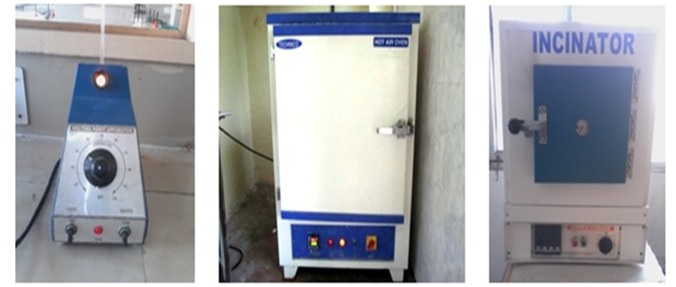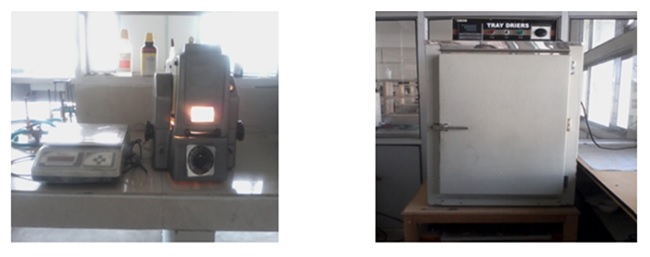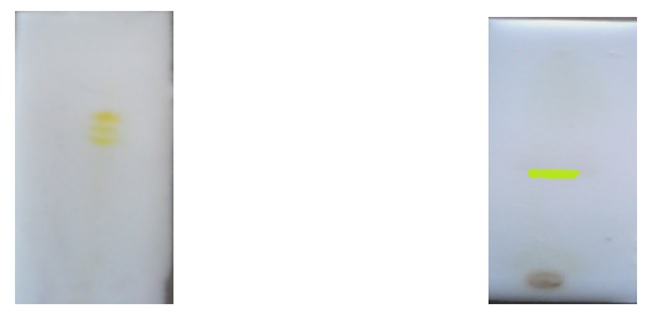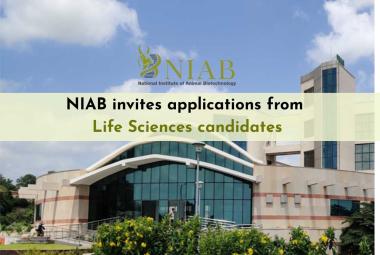{ DOWNLOAD AS PDF }
ABOUT AUTHORS
Seema*, Parminderjit Kaur
Department of Pharmacy,
Rayat Bahra Institute of Pharmacy, Hoshiarpur, Punjab, India
*seemakumar2125@gmail.com
ABSTRACT
Turmeric (Curcuma longa) is a perennial herb, belonging to family Zingiberaceae. The rhizomes and leaves of turmeric were extracted separately with ethanol by Soxhlet extraction and the percentage yield of rhizomes and leaves of Turmeric was 12% and 17% yield respectively. The extract of turmeric rhizomes and leaves can increase the bile flow, offer protection of the gall bladder and also the leaf extract possess anticancer properties. The present study was focused on the isolation of curcuminoids by thin layer chromatography using chloroform: ethanol: glacial acetic acid in a ratio of 95: 5: 1. From TLC the better resolution of Rf value was observed in rhizomes at 0.8, 0.66, 0.51 as Curcumin, Demethoxycurcumin, Bisdemethoxycurcumin respectively whereas Rf value of leaves was 0.42 as Bisdemethoxycurcumin, when visualized under 366nm under bright yellow fluorescent. The phytochemical screening of leaf extracts showed the presence of flavonoids, cardiac glycosides and phenols. The ash value of turmeric rhizomes and leaves was 3.33% and 6.67%, acid insoluble value was 1.3% and 2% and water insoluble value was 13.3% 1nd 16.67% respectively. The moisture content of rhizomes and leaves of turmeric in IR- Moisture balance was found to be 0.93 and 0.30 whereas in Tray Drier the moisture balance was 0.46 and 0.27 respectively while the melting point was observed as 160-1630C and 116-1200C respectively which resembles the report of literature (IP, 2007).
[adsense:336x280:8701650588]
REFERENCE ID: PHARMATUTOR-ART-2438
|
PharmaTutor (ISSN: 2347 - 7881) Volume 4, Issue 10 Received On: 25/03/2016; Accepted On: 19/05/2016; Published On: 01/10/2016 How to cite this article: Seema, Kaur P; Comparative Study of Pharmacognostical and Preliminary Phytochemical Investigation of Curcuma Longa Leaves and Rhizomes; PharmaTutor; 2016; 4(10); 31-36 |
INTRODUCTION
Human being used plants and their products from ancient time for the treatments of the diverse ailments, as traditional and allopathic medicine.[1] With the discoveries of many natural and synthetic drugs, the remarkable progress has been made in the field of medicines. At more than 2000 species of medicinal herbs and spices present in India and they have high potential abilities for Ayurvedic, Unani, Siddha traditional medicines but among them only very few have been studied for their chemical and pharmacological medicinal values.[2] According to the World Health Organization, most populations still rely on herbal medicines for their health requirements, because they cannot afford the synthetic products of pharmaceutical industries, along with their side effects.[3] The primary health care needs of the rural areas of many developing countries still rely on traditional medicine and they found an important place in day-to-day life of rural. The interest in herbal medicines has been revived due to increase in the awareness of the limited availability of synthetic pharmaceutical products in the treatment of major diseases and this emphasize on the need for discovery of new molecular structures as lead compounds from the plant origin.[4] The botanical surveys are carried out in India and elsewhere in the world have reported a number of plants that are used in the treatment of infectious diseases, including Turmeric. Turmeric (Curcuma longa L.) is a medicinal plant, botanically related to ginger belongs to the Zingiberaceae family and it is extensively used in Ayurveda, Unani and Siddha medicine at home remedy for various diseases.[5] Curcuma longa L., is a herbaceous perennial plant with short stem and large oblong leaves, which bear ovate, oblong or often branched rhizomes of brownish-yellow in color.[6] In old time, turmeric as a traditional Hindu medicines are extensively used for the treatment of sprains and swelling caused by injury but in recent times, turmeric powder is used for the treatment of biliary disorders, anorexia, coryza, cough, diabetic wounds, hepatic disorders, rheumatism and sinusitis and moreover it is also considered as a part of religious rituals. India became the world’s largest manufacturer of turmeric as it produces tones of turmeric plants every year. The rhizomes of turmeric are mostly considered as the useful part of plant and leaves was not given care but now Indian and Malaysian cookery are used the turmeric leaves as both fresh and dried-extracted form, as a basic ingredient in curry powders and are purported to improve digestion and reduce gas and bloating. Curcuma longa (Haridra) , Curcuma zedoria (Zedoary), Curcuma aromatica (Vana Haridra), Curcuma caesia (Kali Haridra), Curcuma angustifolia, and Curcuma amada (Amaragandhi Haridra) are species of Curcuma which are traditionally used for their antifungal, antibacterial, wound healing, anticancer, antioxidant and anti inflammatory activity respectively[7]. Turmeric is enriched with many efficacious phyto-constituents which are Curcumin (the principal curcuminoids) and other curcuminoids that are Demethoxycurcumin and Bisdemethoxycurcumin, they are polyphenols and are responsible for the yellow color of turmeric and may be used as a food coloring and as a food additive.
MATERIAL AND METHODOLOGY
Chemicals, solvents and equipment used: All the chemicals and reagents used were of laboratory grade which are Ethanol, chloroform, glacial acetic acid, silica gel G, concentrated sulphuric acid, Hager's reagent, pyridine, ferric chloride solution, molisch's reagent, HCL, sodium nitroprusside, sodium hydroxide, distilled water. Glass wares used were of Borosilicate and equipments are Soxhlet extractors, Microscope (QUASMO India), Hot Air Oven (NSW India), water bath, IR-Moisture balance, Tray Drier (Spruce enterprise Lab Equipment), Weighing balance (Wensar), Incinerator, Incubator, Crucible of Rayat Bahra institute of pharmacy Hoshiarpur.
Collection of Plant Materia: Rhizomes of Curcuma longa were collected from the local area of Nawashar district in March 2015 and Leaves, was collected from Hoshiarpur district in September 2015. The leaves and rhizomes were separated from plants and washed thoroughly in running tap water to clean the adhering sand particles and then rinsed with distilled water.
Preparation of Plant Samples:The leaves of turmeric are dried in shade for 15 days and then dried in hot air oven at 40-500 C temperatures and crushed them in mortar pestle and sieved them through a sieve number 20. The rhizomes are first steamed in their own juice or boiled in water for 12 - 24 hr and vitality that they otherwise obstinately retain, is destroyed[8] then finally the product so obtained is dried in the sun and then powdered them.
Extraction Procedure
- Preparation of Leaf Extract: 10 gm powdered leaves were successively extracted with 150 ml ethanol, using a Soxhlet apparatus in a thimble and extraction, was carried out for 14 hrs at room temperature.[9] The extract was filtered and concentrated further using china dishes on water baths and stored at room temperature for a further experiment.
- Preparation of Rhizomes Extract: 10 gm powdered rhizomes were successively extracted with 150 ml ethanol, using a Soxhlet apparatus in a thimble and extraction, was carried out for 9 hrs at room temperature.[10] The extract was filtered and concentrated at 36°C and stored at room temperature for a further experiment. The practical and percentage yields of the extracts were calculated.
- Morphological studies: The morphological characters like size, shape, apex, margin, base, surface, color, odor and taste of Curcuma longa leaf and rhizome were studied.
Microscopic studies: The required samples of Curcuma longa leaf and rhizome powder were first cleaned and strained with chloral hydrate and then strained with Phloroglucinol and concentrated Hydrochloric acid. Sections were also stained with Iodine solution (I-KI) for starch.[11]
Physicochemical Evaluation: Physical parameters such as moisture content, ash values, acid-insoluble ash, water-insoluble ash, Melting point, were determined as per procedures mentioned in accordance with WHO guidelines.

Fig. 1: A Picture of Melting Point apparatus, Hot air oven and incinerator
NOW YOU CAN ALSO PUBLISH YOUR ARTICLE ONLINE.
SUBMIT YOUR ARTICLE/PROJECT AT editor-in-chief@pharmatutor.org
Subscribe to Pharmatutor Alerts by Email
FIND OUT MORE ARTICLES AT OUR DATABASE
Preliminary Phytochemical Screening: The phytochemical evaluation includes qualitative chemical tests which are used for identification of various phytoconstituents present in the powdered crude drug by taking reference from IP, 2007. The phytoconstituents assayed were Alkaloids, Carbohydrates, Phenols, Terpenes, Resins, Tanins, saponins, Cardiac Glycosides and Anthocyanin.
Chromatographic study (Thin layer chromatography for alcoholic extract): Alcoholic extract of turmeric leaves and rhizomes was subjected to thin layer chromatography with silica gel G as Stationary phase by using chloroform : ethanol : glacial acetic acid as Mobile phase in ratio of 95:5:1 respectively and the individual spot was visualized at 366nm under bright yellow fluorescent under UV chamber.[12] The Rf values for the separated spots were calculated and compared with Rf values of standard compounds.

Fig. 2 : A Picture of TLC plate in TLC chamber and UV chamber
RESULT AND DISCUSSION
Morphological characters: Leaves of Curcuma longa are greenish-yellow in colour, containing characteristics odour, bitter taste, smooth, ovate, acute, entire and 31 x 9.5cm in size along with petiole of 6.1cm long. On the other hand, rhizomes are yellowish-brown in colour with a characteristic odour. Bitter taste having size 5.1 x 2.4 x 0.9cm and cylindrical in shape. Root scars and annulations are present with a rough surface and horny fracture.
Microscopic studies:
Anatomy of leaf: The leafs of Curcuma longa are longa and dorsiventral with distinct midrib from the lamina. The single layered polygonal epidermal cells are present which containing cuticle on the outer layer along with unicellular covering trichome. Moreover, a thick band of xylem and a wide band of phloem are present. The lamina is uniformly flat and petiole is elliptical with even and smooth surface. Tannins can also be seen in some cells.
Powder character Rhizomes: Some cork cells and fibers were seen along with Starch grains and Xylem vessels. Fresh leaves and powder sample of rhizomes were shown similar characters as mentioned in Literature. Hence, from the above microscopical characters of the plant, turmeric was determined genuinely.
Physicochemical parameters: The results of the physicochemical constants of raw material within the limit which is mentioned in Table No:1. This signifies that the quality and purity of raw material.
|
S.NO. |
Parameters |
Analysis %w/w (Rhizomes) |
Analysis %w/w (Leaves) |
Remarks |
|
1. |
Moisture content (Tray drier) |
0.46 |
0.27 |
Acc. to Literature |
|
2. |
Moisture content (IR-Moisture balance) |
0.93 |
0.30 |
Acc. to Literature |
|
3. |
Total ash |
3.33 |
6.67 |
NMT 10% |
|
4. |
Acid insoluble ash |
1.3 |
2 |
NMT 2% |
|
5. |
Water soluble extractive value |
13.3 |
16.67 |
NLT 12% |
|
6. |
Melting point |
160-1630C |
116-1200C |
Acc. to Literature |
|
7. |
Percentage yield |
17 |
12 |
Acc. to Literature |
Table . 1 : Physicochemical parameters of Rhizome and leaves of turmeric
From the present investigation it was observed that The turmeric rhizomes give more percentage yield, melting point, moisture content in IR-moisture balance and tray drier as compared to turmeric leaves and on the other hand turmeric leaves give more total ash value, acid insoluble value and water soluble value.

Fig. 3 : A picture of IR-Moisture Balance with electronic balance and Tray Drier
Preliminary Phytochemical Screening: The phytochemical preliminary screening of the ethanol extract of Curcuma longa leaves and rhizomes showed the presence of various secondary metabolites. Alkaloids, phenol, tannin, flavonoids, saponins, cardiac glycoside, carbohydrates, phenol, resin were the most prominent and the result of phytochemical test has been summarized in (Table 2). Flavonoids, alkaloids, and phenolic compounds are compounds that act as primary antioxidants and subsequently they may be used for the cure of many ailments in the future.
|
Parameters |
Observation in Ethanol Extract |
|
|
|
Rhizomes |
Leaves |
|
Alkaloids |
+ |
- |
|
Carbohydrates |
+ |
- |
|
Phenols |
+ |
- |
|
Terpenes |
+ |
+ |
|
Resins |
+ |
- |
|
Tanins |
+ |
- |
|
Saponins |
+ |
- |
|
Cardiac Glycosides |
+ |
- |
|
Anthocyanin |
+ |
- |
Table 2: Preliminary Phytochemical Screening
(+ presence of the compound, - absence of compound):
Chromatographic study (Thin layer chromatography): A chromatographic study of curcuminoids present in Curcuma longa was undertaken. The Rf value of intense spot obtained with the test sample was matched with Rf value of the standard curcumin. Two more less intense spots were observed with the test solution. These spots may be due to the presence of other curcuminoids in the isolated curcumin. The spot was visualized at 366nm under bright yellow fluorescent.
|
S.No. |
Sample |
Rf value |
|
1. |
Standard[13] |
Spot 1: 0.79 (curcumin) |
|
|
|
Spot 2: 0.60 (desmethoxycurcumin) |
|
|
|
Spot 3: 0.43(bisdesmethoxycurcumin) |
|
2. |
Test sample (turmeric rhizomes) (yellow spot) |
Spot 1: 0.8 |
|
|
|
Spot 2: 0.66 |
|
|
|
Spot 3: 0.51 |
|
3. |
Test sample (turmeric leaves) (light green spot) |
Spot 1: 0.42 |
Table.3: Results of TLC study of curcuminoids

Fig 4 : Apicture of TLC of rhizome and leaves of turmeric
CONCLUSION
In these present investigations, various pharmacognostical parameters such as macroscopic, microscopy, preliminary phytochemical screening and TLC profiling were carried out which could be helpful in authentification of Curcuma longa. The result of the present study will also serve as reference material for the preparation of herbal monograph. Further studies of the present investigation may recommend for the isolation of bioactive constituents and biological assay methods for the standard drug preparations. Families of secondary metabolites responsible for the activities of the crude solvent extracts have also been determined.
ACKNOWLEDGEMENT
We are thankful to Rayat Bahra Institute of Pharmacy, Hoshiarpur for providing financial assistance for research work. We are thankful to Assistant Professor of Parminderjit Kaur, for reading this and offering suggestions. Special thanks to Assistant Professor Mandeep Singh and Seema, for helping me in my experiments.
REFERENCES
1. Sen, A., Batra A.; Evaluation of Antimicrobial Activity of Different Solvent Extracts Of Medicinal Plant: Melia Azedarach L.; International Journal of Current Pharmaceutical Research; 2012; 4(2); 67-73
2. Shanmugam, S., Bhavani, P.; Studies On The Comparison of Phytochemical Constituents And Antimicrobial Activity of Curcuma Longa Varieties; International Journal of Current Microbiological And Applied Sciences; 2014; 3(9); 573-581.
3. Mustapha, A. A., Enemali, M.O., Olose, M., Owuna, G., Ogaji, J. O., Idris, M. M., Aboh, V. O.; Phytoconstituents And Antibacterial Efficacy Of Mango (Mangiferaindica) Leave Extracts; Journal Of Medicinal Plants Studies; 2014; 2(5); 19-23
4. Arutselvi, R., Balasaravanan, T., Ponmurugan, P., Saranji, P. M., Suresh P.; Phytochemical Screening And Comparative Study Of Anti Microbial Activity Of Leaves And Rhizomes Of Turmeric Varieties; Asian Journal Of Plant Science And Research; 2012; 2(2); 212-219.
5. Dhamija, H. K., Chauhan, A. S.; Herbs: Now in arena of hyperlipidaemia; Der Pharmacia Sinica; 2011; 2(3); 51-59.
6. Maria M. LoTempio, Mysore S. Veena, Helen L. Steele, Bharathi Ramamurthy, Tirunelveli S. Ramalingam, Alen N. Cohen, Rita Chakrabarti, Eri S. Srivatsan, and Marilene B. Wang; Curcumin Suppresses Growth of Head and Neck Squamous Cell Carcinoma; Clin. Cancer. Res.; 2005; 11(19); 6994-7002.
7. Manimegalai V., Selvaraj T.,. Ambikapathy V.; Studies on Isolation and Identification of VAM Fungi in Solanum viarum Dunal of Medicinal Plants; Advances in Applied Science Research; 2011; 2(4); 621-628.
8. Wallis, T.E.; Textbook of Pharmacognosy; CBS Publisher And Distributer; New Delhi; 2005; 5; 388.
9. Saifur. R. M., Hasan K.D.B, Jahan, M., Biswas, S. K., Haque1, M. A., Islam, M. R., Haque, M. E., Sarkar, T., Biswas, N.; Ethanol Extract Of Curcuma Longa Leaf, A Potential Drug Candidate Against Bacillus Species Mediated Infections; International Journal Of Biosciences; 2014, 4(7); 9-14.
10. Revathy, S., Elumalai1, S., Benny, M., Antony, B.; Isolation, Purification And Identification Of Curcuminoids From Turmeric (Curcuma Longa L.) By Column Chromatography; Journal Of Experimental Sciences; 2011; 2(7); 21-25.
11. Jain, V. C., Shah, D. P., Sonani, N. G., Dhakara, S.,. Patel, N. M.; Pharmacognostical And Preliminary Phytochemical Investigation of Lawsonia Inermis L. Leaf; Rom. J. Biol. – Plant Biol.; 2010; 55(2); 127–133
12. Mukherjee P.K.; Quality Control Herbal Drugs - The Approach To Evaluation of Botanical Business Horizons; New Delhi; 2008; 3; 728.
13. Pokhrel, B., Raut S., Rijal, S.; Phytochemical Screening; Antimicrobial And Antioxidant Activity of Melia Azedarach Leaves in Methanol; World Journal Of Pharmacy And Pharmaceutical Sciences; 2015; 4(7); 1562-1575
14. Shah, B., Seth, A.K.; Textbook of Pharmacognosy And Phytochemistry; Elseiver; New Delhi; 2014; 2; 450.
NOW YOU CAN ALSO PUBLISH YOUR ARTICLE ONLINE.
SUBMIT YOUR ARTICLE/PROJECT AT editor-in-chief@pharmatutor.org
Subscribe to Pharmatutor Alerts by Email
FIND OUT MORE ARTICLES AT OUR DATABASE









